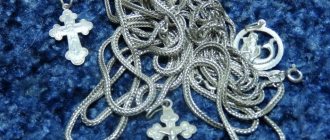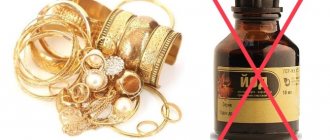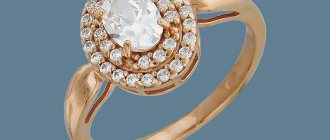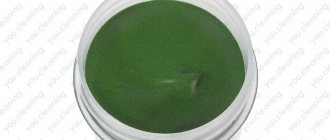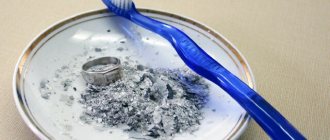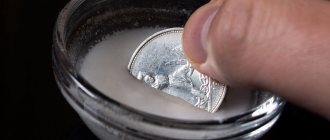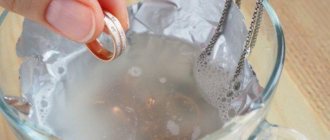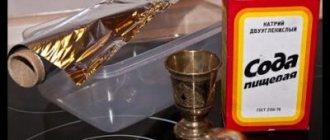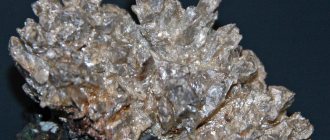There are several main reasons why silver is melted down. Firstly, when they want to clean it and, accordingly, raise the price. A large amount of low-grade, unused silver can be used to produce bullion that will fetch a good price. Fashion in style and design of jewelry changes quickly, and what was worn in the last decade is often outdated and not used. Purchased jewelry is stored on shelves that no one needs. And it happens that you just don’t like the jewelry and therefore don’t wear it. Sometimes it happens that antique silver forks left by inheritance lie unused.
Instead of spending money on new items, you can melt down the ones you have and get beautiful, custom items at a low price.
How can you melt silver and remove harmful impurities? This problem can be solved without any problems! If you have the necessary equipment, tools and materials, you can handle it even at home.
How to clean silver: popular methods
You want to wear your favorite jewelry 24 hours a day and not take it off, but silver items begin to darken over time.
This can occur under the influence of soap, skin care products, or simply high humidity. Cleaning silver jewelry at home will save your favorite rings and bracelets and return them to their original appearance. The procedure does not take much time, and the number of options is extensive. Liquid for cleaning silver can be bought in a store, or prepared from improvised means. Some of them are already in your home, while others will have to run to the store. Professional cleaning products cost money, but at the same time they guarantee almost 100% results. After this, you just need to take care of the jewelry, preventing history from repeating itself.
To remove blackness from 925 silver, you don’t have to go to a jewelry store; you can use soda, ammonia, peroxide, vinegar and similar products. Citric acid, toothpaste and even Coca-Cola will help clean a silver chain, bracelet, ring or cross!
Cleaning with foil and baking soda
You can clean silver using baking soda and foil in a few minutes. This recipe is considered one of the fastest and most effective. First of all, you need to boil water, add soda to it (50 g/1 liter of water). After boiling, pour the solution over the darkened decoration. Due to the chemical reaction of silver sulfide with soda and aluminum, the blackness will disappear in a couple of minutes. After this, all you have to do is wipe the jewelry dry. This is the most effective silver cleaner. It is important to remember that you should never use dry soda, it will only ruin the metal.
Ammonia
Another way to restore your jewelry to its former shine is to wash the silver with a solution of ammonia and water. Ammonia is considered an excellent solvent; it will help to better clean silver from plaque or dirt without damaging the product itself.
Pour water into a small container, add ammonia in a ratio of 1 to 10, put in the decorations and leave them for 30 minutes. If after half an hour it was not possible to return the shine to silver, you need to keep it longer in the solution. After the procedure, all that remains is to wipe the rings, chains or bracelet dry. Cleaning silver with ammonia at home is very simple and quick.
Hydrogen peroxide
Hydrogen peroxide also cleans silver well, but its use can lead to unexpected results. The fact is that the substance can both oxidize and reduce compounds. In one case, when using peroxide, you will get a brightened product, in another - jewelry with plaque or stains. It all depends on the amount of impurities in the silver product. You can clean silver from blackness using peroxide with the addition of ammonia, but even in this case you need to act with extreme caution. It would be best to test the product on a small area of the product; if it becomes lighter, the procedure can be continued.
Vinegar
If you soak tarnished silver items in vinegar, you are unlikely to achieve a good result. 6% vinegar should be preheated, but you are unlikely to like the smell. If you decide to wash old silver that has turned black, yellowed or oxidized using this folk method, bring the liquid to a temperature of 50 degrees. You can whiten silverware in 15-20 minutes. After the procedure, all items should be thoroughly rinsed and wiped with a dry cloth.
Lemon acid
Citric acid will help to effectively clean silver. It is diluted with water in a ratio of 100g/0.5l of water. You need to boil the jewelry in this solution for half an hour, and then rinse it thoroughly with water.
Toothpaste
Someone manages to clean silver with tooth powder. This is not the worst way, but it is very time-consuming. You will have to lighten the jewelry manually, armed with a brush. Toothpaste for cleaning silver is suitable if there are no more effective products at hand. The advantage of this method is that it allows you to very quickly remove dirt and plaque from small items.
Coca Cola
Cleaning silver with Coca-Cola is one of the most exotic and radical methods. The drink is considered a good solvent and absorbent. You need to boil the cola and boil the contaminated products in it for 5-7 minutes. You can simply throw the jewelry into a glass of cold cola and leave it for a few hours, this method should also work. After this, the silver must be washed with water and wiped.
Paste GOI
You can clean silver with GOI paste, but remember that this is a very troublesome and dangerous method. This is a special product for polishing silver jewelry; it can be purchased in specialized stores. GOI paste is applied to a piece of cloth moistened with gasoline (this is done so as not to scratch the surface of the product). Silver is processed very carefully and patiently. It takes a lot of time, but the result is worth the effort.
How to get pure metal?
The third stage of electrolysis requires:
- the bottom of a plastic bottle (two-liter);
- power supply;
- coffee filter;
- stainless fork;
- brass stick;
- electrical tape;
- insulation tubes.
Pure silver is welded to a fork, but so that the edge of the ingot remains hanging. Using electrical tape and pliers, an imitation cathode is made from a fork. An anode stick is passed through the filter, and distilled water is added to the silver solution so that the total volume of the solution is two liters.
The resulting solution is poured into the cut-off part of a plastic bottle, a stick with a tea filter is suspended and a fork is immersed in the container. After all this, turn on the power supply, while monitoring the current (it should not exceed 5 amperes) and voltage (permissible fluctuation from 4 to 8 volts). The reaction will cause the bar to dissolve and crystals to separate. The crystals are washed and then fused by casting into water. All these techniques allow you to obtain silver of a maximum 999 standard.
When working with metal and reagents, you should follow safety rules - protect your hands with gloves, avoid contact of chemicals with mucous membranes, and also work in a well-ventilated area.
How to clean silver with stones
You can clean silver rings with stones in a jewelry store or at home. You should focus on the density of the stones. Aquamarine, emerald and sapphire can be cleaned with washing powder; laundry soap will help remove grease and dirt from malachite, moonstone, opal and turquoise. Silver earrings with ruby or garnet stones should not be immersed in hot water. It is important to clean jewelry with inserts very carefully and carefully: do not damage the insert itself or loosen the fastenings. Products containing amber, coral or pearls should be washed with lukewarm water and soap. Aggressive cleaning agents can destroy the structure of the stone.
How to clean rhodium plated silver
Rhodium is a noble platinum group metal that is sometimes used to coat silver jewelry, giving it shine and durability. You can clean rhodium-plated silver at home with special liquids for cleaning jewelry, napkins or a velvet rag soaked in warm water. A bath of soapy water helps remove stains from rhodium-plated silver; the jewelry is immersed in water for a few minutes. Some people prefer to wipe such products with cotton swabs soaked in glycerin. If all of the above methods do not help, it is better to take the jewelry to a jewelry workshop. Specialists will restore the rhodium-plated coating using the galvanic method.
Cleaning methods
There are 2 methods of refining to purify technical silver:
- Cupellation: this cleaning method is only suitable if the alloy contains lead, but does not contain gold, platinum and other platinum group metals. The principle of cupellation is based on the fact that during this procedure, lead is oxidized under the influence of air and separated from the alloy. To carry out cupellation, a special furnace is required, equipped with a bowl-shaped crucible, covered with marl. First of all, the furnace is heated well, after which a crucible with a silver alloy is placed in it. When the crucible is heated to full melt, the furnace should be opened and air should be allowed to enter. After the chemical reaction between lead and crucible is completed, the alloy is removed from the furnace and poured into molds. If the alloy has a rainbow shimmer, this indicates the presence of silver and other precious metals in it.
- Purification by electrolysis: for electrolytic refining, you will need plastic or sandstone cells containing silver nitrate, and the metal in such a substance should be no less than 50 grams per 1 liter. You will also need nitric acid and distilled water. When purifying silver by electrolysis, thin strips of stainless steel will act as the cathode, and silver, which needs to be cleansed from impurities of other metals, will act as the anode. The metal is placed in a fabric bag. Nitric acid is mixed with water in equal parts and then stirred with a quartz stick. The solution is poured into reagent containers. Then you need to fill the metal with the solution and leave it covered for 8 hours. After the time has passed, you need to take the copper sticks and dip them in dissolved silver (silver nitrate). Fragments of copper pipes, cleaned of corrosion, are suitable as copper sticks. You need to be prepared for the tubes to dissolve, so you will need to add new ones to the solution. The end of the reaction can be determined by the absence of its signs and the formation of a thick silvery precipitate. This is what needs to be filtered. To do this, prepare a container, funnel and coffee filters. Filtration is repeated 5 times or more, because this will clear the silver precipitate from copper nitrate.
Important: The separated liquid may contain silver. To separate it, you need to add rock salt to the liquid and wait several hours for the metal to separate.
After manipulation, excess water is evaporated from the cement.
The next stage of electrolysis is melting in a crucible. The precipitate is heated evenly, after which the metal is cast into water. At the end of the manipulation, grains should be formed, the purity of which is 980. For this reason, such grains require additional purification to obtain pure silver. First of all, the piece of metal must be melted down, after which it will be ready for the next stage of cleaning.
Cleaning blackened silver at home
Blackened silver is rarely found in jewelry stores, but it is plentiful at flea markets and in grandma's chests. A touch of antiquity will give the product nobility, but a touch of dirt and dust - not so much. You can clean black silver with soda and salt and a cleaning agent, a regular school eraser, or ammonia with crushed chalk. There is no guarantee that the product will regain its original shine, but it will look much fresher and cleaner.
How much does technical silver cost now?
Technical silver. Wholesale price for silver from 1 kg.
| Name | wholesale price | |
| SILVER 99% wire, contacts, plates, housings from K52 type capacitors, etc. | kg | 40000 |
| SILVER 80% non-magnetic | kg | 32000 |
| SILVER 60% magnetic | kg | 24000 |
| SILVER 20-25% on copper, SILVER 20-25% cut with MKS (bit ends with relay) | kg | 10000 |
Jeweler's tips for cleaning silver
You can properly clean tarnished silver at home without difficulty if the jewelry is not inlaid with stones or other inserts. An incorrectly selected cleaning agent can destroy the structure of the stone and damage the fastenings. You can rub the silver so that it shines like new with a velvet cloth or special napkins, usually sold in jewelry workshops. There, the master will help restore the appearance of silver jewelry, if this cannot be done on your own. With the help of special equipment and clean products, this will take no more than an hour. Polishing silver items is not difficult, but it will be pointless if you do not take care of the jewelry in the future.
Cleaning methods
Industrial metal can be cleaned using several methods, of which 5 are the most effective.
Cupellation
Suitable only if the alloy contains lead rather than gold and other platinum group metals.
To carry out refining using this method, the following are used:
- a special oven covered with porous limestone clay (marl), which absorbs lead oxide;
- bowl-shaped crucible.
The crucible with the alloy is placed in a preheated furnace. When the contents acquire a liquid form, the stove is opened to a stream of air, under the influence of which the lead oxide evaporates, separating from the alloy.
The procedure is considered complete when the surface of the remaining alloy acquires a rainbow color - this indicates that it contains silver and other precious metals.
Electrolysis
This method is more universal, but it is only used if the initial proportion of silver in the alloy is at least 80%.
Electrolysis is carried out in special cells made of plastic or sandstone that contain silver nitrate, and the metal in such a solution must be at least 20 grams. per 1 liter.
To extract silver using the electrolytic method you need:
- In a glass or plastic container, dilute distilled water and 70% nitric acid in equal proportions.
- Then this solution is poured into the metal so that it does not occupy more than a third of the container, since the process can occur violently.
- Cover carefully and leave for up to 8 hours.
During the process, gaseous nitrogen dioxide of a brown hue is released. The solution may change color towards the end of the reaction. Depending on the predominant amount of different metals, it will become:
- blue - from copper;
- green – from iron;
- blue - from silver.
At the end of the process, you need to pour the mixture into a separate jar and let it cool.
The next step is to obtain the silver precipitate from the solution using copper.
Wires or tubes that have been previously cleaned of dirt and oxide are suitable for this. When copper is added, silver is deposited on it in powder form. To speed up the process, this sand is shaken into the solution. After which the sediment is filtered and melted into an ingot.
It, in turn, can be cleaned using the electrolytic method.
Electrically charged particles are placed in a plastic container filled with the previously obtained silver solution (the anode is the resulting ingot, the cathode is stainless steel plates). The voltage must be created no more than 4-8 Volts, the current strength must be up to 5 mA. At the end, silver nitrate will dissolve, and pure silver will settle in crystals.
Refining with electrolyte and ammonium nitrate
This purification method is suitable for those who cannot purchase HNO3.
The electrolyte contains sulfuric acid, which reacts with ammonium nitrate when heated. As a result of heating, a stable compound of nitric acid is formed, which dissolves the alloy.
- Place the necessary raw materials, 150 g, into a three-liter bottle. saltpeter, 300 ml of electrolyte and place it on sand heated by an electric stove.
- When heated, boiling will occur, a reddish gas will be released, the moisture will change color and acquire a bluish tone.
- After the metal has completely dissolved, hot liquid is added up to the neck, then table salt is added to form silver chloride flakes.
- They are separated from the water.
- In the same bottle, the filtered raw material is filled with hydrochloric acid 2 cm above the sediment.
- Zinc shavings are poured there, which interacts with HCl and pushes out the metal, releasing hydrogen.
- After about half an hour, a precipitate of silver will fall out, which is washed and melted into an ingot.
Chemical method
This method is used to extract metal from solutions or salts.
First, sodium sulfate is added to the mixture to produce silver sulfate. Then, adding table salt produces silver chloride. The resulting moisture is settled, divided into fractions (transparent and cloudy).
Silver chloride is mixed in equal parts with soda (potassium carbonate) and melted. The metal is then heated and melted again.
Acid free
You can separate precious metal from an alloy using salts. First, the material being processed is brought to a very thin state.
- A glass container is installed on the stove with a sand bath, into which ammonium chloride and nitrate are placed in a 2:1 ratio and the necessary raw materials.
- While the mixture is heating, it needs to be stirred.
- Within 10 minutes, the metal will begin to melt, releasing a white gaseous substance, separating silver chloride.
How to care for silver
Silver is loved for its nobility at an affordable price. Products made from this metal can serve their owner for many years, but caring for silver jewelry requires care and patience. Silver is most often subject to deformation due to its softness; it becomes covered with scratches, can bend and turn black. To prevent silver from tarnishing, it should be cleaned regularly. You can do this on your own and with improvised means that are present in every person’s household, or you can take it to a master. The latter option costs money, but you will receive the jewelry back intact, like new.

